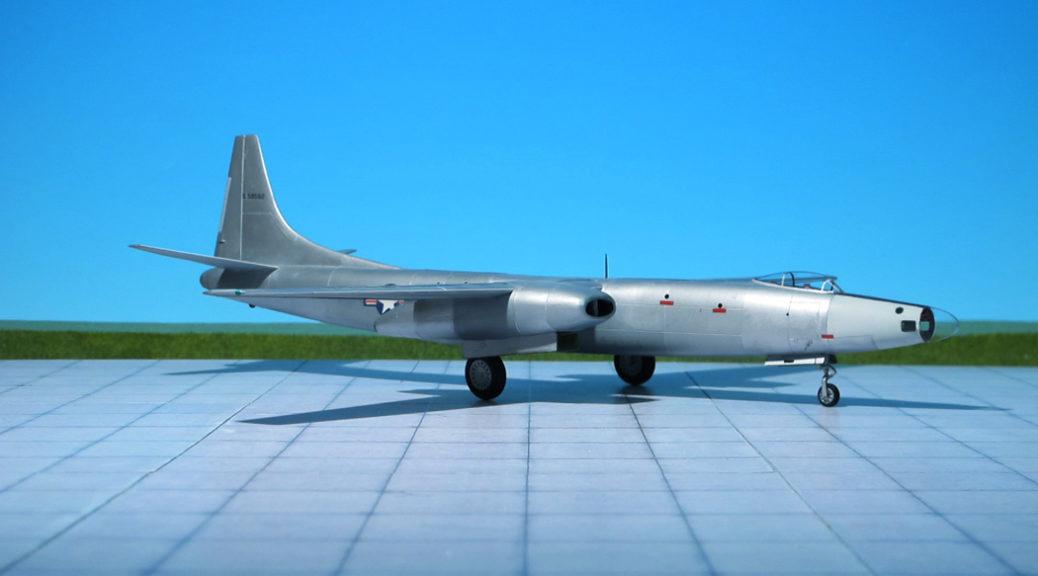TYPE: High-speed medium bomber
ACCOMMODATION: Crew of three
POWER PLANT: Four Allison J35A-3 turbojet engines, rated at 1.815 kp each
PERFORMANCE: 439 mph at 15,000 ft
COMMENT: In 1944, the US War department was aware of aviation advances in Germany and issued a requirement for a range of designs for medium bombers weighing from 36,287 kg to more than 90,718 kg. Designs from this competition, sometimes named the “Class of ’45”, included the Convair XB-46, the Martin XB-48, and the North American XB-45 “Tornado”.
In the fall of 1945, Convair found it was competing with itself with its XB-46 turbojet bomber when the USAAF became interested in an unorthodox forward-swept wing turbojet attack design, the Convair XA-44 that the company had also been working on. With the end of WW II severely curtailing budgets, the company considered canceling the XB-46 in favor of the other project as there was insufficient funding for both. Company officials argued that it made more sense to allow them to complete the XB-46 prototype as a stripped-down testbed omitting armament and other equipment and for the USAAF to allow them to proceed with two XA-44 airframes in lieu of the other two XB-46s on contract. In June 1946, the USAAF agreed to the substitution but that project was ultimately cancelled in December 1946 before the prototypes were completed. The XB-46 would be completed with only the equipment necessary to prove its airworthiness and handling characteristics.
The Convair XB-46 was a graceful design and had a long streamlined oval torpedo-shaped fuselage, long narrow straight shoulder-mounted wings with four Chevrolet-built Allison J35-C3 axial-flow eleven stage turbojets of 1.730 kp static thrust paired in an integral nacelle under each wing. The fuselage turned out to be a problem, as it distorted under flight loads. The pilots sat in tandem in a pressurized fighter-style cockpit under a single Plexiglas teardrop canopy with the bombardier-navigator-radio operator in a transparent Plexiglas nose section.
The straight wing had an aspect ratio of 11.6, and was equipped with Fowler flaps which extended over 90 percent of the span, in four sections. The flaps extended via electrical actuators, and had very small ailerons. Each wing had five spoilers made of perforated magnesium alloy. The engine air intakes were flat oval inlets, with a duct curving downward in a flat “S” to the engines, which were mounted behind the leading edge of the wing. The unusual flight control system utilized a system of pneumatic piping to transmit the pilots control inputs and actuate various systems, rather than the more typical hydraulic, manual or electrical control lines and systems of most aircraft of the era.
Production versions were to be equipped with a pair of .50 caliber Browning M2 machine guns in a tail turret designed by Emerson Electric Company and provision was made for an APG-27 remote control optics and sighting system, but no weaponry was fitted into the prototype.. Likewise, production aircraft were intended to be built with the General Electric J47 engines with 2.345 kp static thrust rather than the J35s used on the prototype
The XB-46’s first flight occurred 2 April 1947 after a month of taxi testing, and lasted ninety minutes. The pilot praised its handling qualities. Basic flight testing took place for five months, and by September 1947 it was concluded after 127 hours aloft on 64 flights by both the Convair Company and USAAF test pilots. Stability and control were excellent but there were engineering problems with engine de-icing, the cabin air system, and vertical oscillations caused by harmonic resonance between the wing and spoilers. There was also concern regarding the ability of the three man crew to exit the aircraft in case of an emergency, since the exit plan relied on the pneumatic system to hold the main door open against the airstream.
The B-46 program was cancelled in August 1947, even before flight testing had been completed, because it was already obsolete. The North American B-45 “Tornado” already had production orders, and even it would be eclipsed by the Boeing B-47 “Stratojet’s” superior performance (Ref.: 24).














